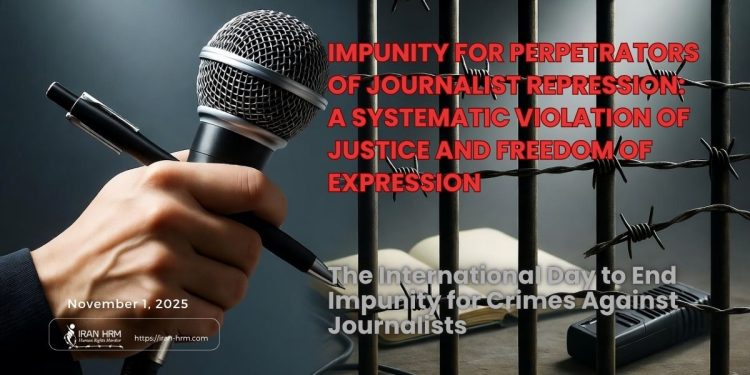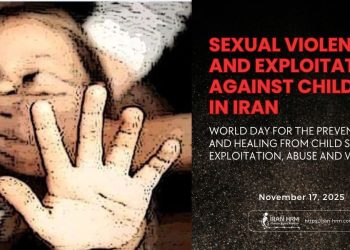November 2 marks the International Day to End Impunity for Crimes Against Journalists — a day established by the United Nations General Assembly in 2013 to emphasize the duty of states to investigate, prosecute, and punish those responsible for crimes against members of the press. While press freedom faces growing threats worldwide, in Iran, impunity for crimes against journalists has become an entrenched feature of the ruling system and a deliberate instrument of repression.
According to UNESCO data, since 2006, 85% of journalist murders worldwide have gone unpunished. The Committee to Protect Journalists (CPJ) ranks Iran among the top ten countries with the highest levels of impunity in crimes against journalists — a clear indication that not only are journalists under constant threat, but justice itself is systematically denied.
Institutionalized Impunity and the Suppression of Journalism under the Ruling Regime in Iran
In the ruling regime in Iran, security and judicial bodies have become instruments of suppression rather than protectors of the law. Arbitrary detentions, heavy sentences, and the systematic denial of fair trial rights for journalists have become a permanent feature of the state’s apparatus of control.
In October 2023, after thirteen months of detention, two women journalists, Niloofar Hamedi and Elaheh Mohammadi, who reported on the killing and funeral of Jina (Mahsa) Amini, were sentenced to thirteen and twelve years in prison respectively — seven and six years of which are enforceable — on fabricated charges of “collaboration with a hostile state.”
In December 2023, Sara Masoumi, a journalist, was sentenced to six months in prison and a two-year ban from journalistic activity for posting a tweet. In August 2023, Marziyeh Mahmoudi was fined and exiled to the remote city of Torbat Jam. Nazila Maroufian, a 23-year-old journalist from Saqqez, was arrested in July 2023 after being summoned to Evin Court and later suffered a heart attack before her court hearing due to sustained psychological pressure. In March 2023, Anahita Ramazanian was sentenced to seven months in prison and forty lashes. Yalda Moayeri, a veteran photojournalist with over two decades of experience, received six years in prison and mandatory forced labor in public parks. In December 2022, Ziba Omidifar, a Kurdish journalist from Qorveh, died under torture in the detention center of the Islamic Revolutionary Guard Corps in Sanandaj. None of the responsible officials were prosecuted.
These cases illustrate that repression of journalists in Iran is not incidental but systemic. Security officers and judicial figures responsible for these abuses enjoy complete impunity and often receive promotions rather than punishment. A striking example is Saeed Mortazavi, the former Tehran prosecutor, who despite his direct role in the killing of Zahra Kazemi, later obtained a law license and now works as an attorney — a stark symbol of institutionalized impunity within the clerical regime.
The Case of Zahra Kazemi: A Historic Example of Impunity for Those Who Suppress Journalists
The case of Zahra Kazemi, an Iranian–Canadian photojournalist, remains one of the most well-documented examples of state impunity for crimes against journalists in Iran. In July 2003, while reporting on families of political prisoners gathered outside Evin Prison, she was arrested and, eighteen days later, died under torture.
Medical reports confirmed that she died from “a cerebral hemorrhage caused by severe blows,” and evidence of torture was visible on her body. Despite overwhelming proof, no senior security or judicial officials were prosecuted. Saeed Mortazavi, Tehran’s then prosecutor and the official identified as directly responsible for her interrogation, was never held accountable. Instead, he later received his law license and now practices within Iran’s judiciary — a clear manifestation of the clerical regime’s structural impunity for those involved in repression and torture.
Mass Arrest of Journalists during the 2022 Nationwide Uprising
Following the nationwide uprising that began in September 2022, mass arrests of journalists became a key tactic of the regime to conceal the truth. Documented data indicate that at least 20 journalists and media activists were summoned or detained in various cities during the first weeks of the protests.
List of Detained Journalists during the 2022 Nationwide Uprising
| No. | Name | City / Place of Arrest | Date (Gregorian) | Media Affiliation |
| 1 | Niloofar Hamedi | Tehran | 22 September 2022 | Shargh Daily |
| 2 | Yalda Moayeri | Tehran | 20 September 2022 | Photojournalist |
| 3 | Marziyeh Talaei | Saqqez | 20 September 2022 | Mokrian News Agency |
| 4 | Ali Khatibzadeh | Saqqez | 20 September 2022 | Mokrian News Agency |
| 5 | Khosro Kurdpour | Saqqez | 20 September 2022 | Editor-in-Chief, Mokrian |
| 6 | Masoud Kurdpour | Saqqez | 21 September 2022 | Journalist, Mokrian |
| 7 | Batoul Balaei | Sirjan | 21 September 2022 | Local Journalist |
| 8 | Samira Alinejad | Sirjan | 21 September 2022 | Local Journalist |
| 9 | Fatemeh Rajabi | Tehran | 23 September 2022 | Media Activist |
| 10 | Elaheh Mohammadi | Tehran | 23 September 2022 | Ham-Mihan Newspaper |
| 11 | Mojtaba Rahimi | Qazvin | 22 September 2022 | Independent Journalist |
| 12 | Alireza Khoshbakht | Tehran | 22 September 2022 | Journalist |
| 13 | Rouhollah Nakhaei | Tehran | 22 September 2022 | Journalist / Media Activist |
| 14 | Vida Rabbani | Piranshahr | 23 September 2022 | Journalist |
| 15 | Elnaz Mohammadi | Tehran | 23 September 2022 | Journalist |
| 16 | Hamed Shafiei | Tehran | 23 September 2022 | Journalist |
| 17 | Ahmad Halabisaz | Tehran | 22 September 2022 | Photojournalist |
| 18 | Mehrnoush Tafian | Ahvaz | 27 September 2022 | Civil Activist / Journalist |
| 19 | Farshid Ghorbanpour | Tehran | 25 September 2022 | Writer / Publisher |
| 20 | Alireza Jabari-Darestani | Tehran | 23 September 2022 | Journalist |
Women Journalists: Victims of Double Discrimination and Structural Violence
Women journalists in Iran face a dual form of repression — both as professionals and as women. In addition to security threats, they endure organized harassment, professional exclusion, and gender-based humiliation. Iran’s press law offers no gender-specific protections. Many women journalists work under temporary contracts, earn minimal pay, and have no legal protection against arbitrary dismissal or arrest.
In recent years, numerous women journalists have been arrested or handed unjust sentences — a reflection of a deliberate policy to silence women’s voices in the media and public life.
Legal Analysis and Violations of International Obligations
The ruling regime in Iran, as a state party to the International Covenant on Civil and Political Rights (ICCPR) and the Convention Against Torture (CAT), is obligated to respect freedom of expression and fair trial rights. In practice, however, arbitrary arrests, torture, and heavy sentences against journalists constitute direct violations of these international treaties. The UN Fact-Finding Mission on Iran (2024) confirmed that the regime’s treatment of journalists and protesters may amount to crimes against humanity.
The judiciary’s failure to prosecute perpetrators represents a double denial of justice — first against the victims, and again against an entire society deprived of the right to know.
Conclusion and Call to Action
Impunity for those who repress journalists is a defining feature of the clerical regime’s survival. From Zahra Kazemi to the journalists of the 2022 uprising, justice has been systematically denied through lies, concealment, and political protection.
This ongoing impunity constitutes a blatant violation of Iran’s international obligations and a direct assault on the public’s right to truth. The international community must invoke Universal Jurisdiction to ensure accountability for the masterminds and perpetrators of these crimes. Domestically, the immediate repeal of vague “national security” laws, guaranteed access to independent legal counsel, and reform of the Press Law to protect women journalists are essential first steps toward restoring basic justice.
As long as journalists in Iran cannot write without fear of arrest, torture, or death, speaking of freedom and justice will remain nothing more than an empty slogan.







